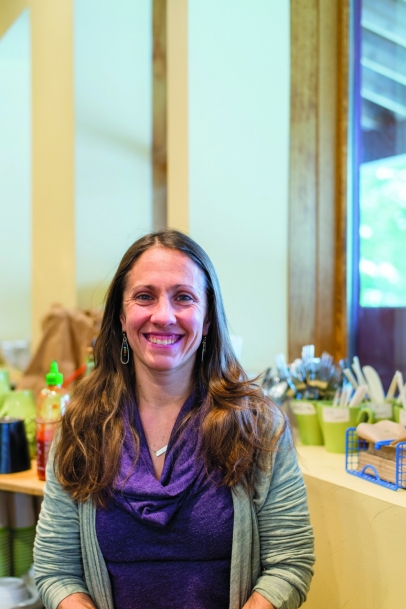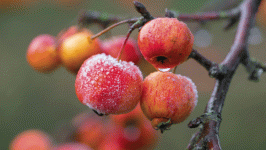Wynde Kate Reese: Green Goddess of the High Peaks
Wynde Kate Reese embodies healthy eating and balanced living. Reese grew up in Tupper Lake and decided to keep her roots in the High Peaks. This dynamic “Veggiecator” radiates energy and passion as she expounds on holistic nutrition. Reese and her business partner, Tammy Loewy, have owned Green Goddess Natural Market in Lake Placid since 2007, and the pair was named New York State Small Business People of the Year in May 2016, a well-deserved honor reflecting the women’s entrepreneurial spirit.
So how did you get where you are today?
Tammy and I started in 2004 with a small tent at the Lake Placid farmers’ market. We were preparing vegetarian foods made with ingredients from the farmers’ market, hoping to inspire people with ideas of how they could shop, cook and eat more healthfully. We did that for three years until we bought a pre-existing natural foods store in Lake Placid and converted it into our own vision. We started the Scape Café when we moved to our current location in January 2013.
You also run the Nordic Café at Mount Van Hoevenberg?
Yes, Mount Van Hoevenberg approached us after fielding a lot of requests from Nordic skiers about getting healthier food into the café. So in December 2014, we opened a satellite café for the winter season, which runs until April if the snow cooperates. Since we’re located right between Lake Placid and Keene Valley, we get a lot of travelers passing through. We make breakfast sandwiches, wraps and soups each day. Our most popular items are the Norseman breakfast burrito with egg, black bean spread, salsa and cheddar on a whole-wheat wrap, and the Loppet grilled sandwich with pesto, natural turkey, roasted red peppers, onion and provolone.
What inspired you to pursue nutrition as a career?
I lived in Central America and saw the negative effects of our American diet on an indigenous culture. That inspired me to teach about whole food cuisine as an alternative to consuming chemically processed food. I try to empower people to make healthier food choices.
You seem to be a natural teacher.
Veggie education is a passion of mine so I work with the Farm to School initiative, doing a lot of teaching, tasting and cooking lessons. The Lake Placid Center for the Arts sponsors an after-school program, and I designed “Kids in the Kitchen,” a no-cooking cooking class. Each session focuses on a different theme using fresh whole ingredients: drinks and beverages, dips and spreads, salads and healthy desserts. Kids can make these at home on their own without using the stove or oven. It’s a great way to get them comfortable in the kitchen and learning how to prepare healthy and really delicious foods!
I also do a series with the students in Hamilton College’s Adirondack Adventure semester, based here in Keene from August through December. I teach them how to cook for a group. We cover cooking for a group, knife skills and menu building.
So what tips can you share about maintaining wellness?
Every morning, start with a deep breathing exercise. Breathing deeply helps to clean our blood by removing the carbon dioxide and increas- ing oxygen. Drink lemon with hot or room temperature water. That gently purifies the liver, kidney and gall bladder and helps to filter toxins. And eat cultured foods, which provide beneficial bacteria to aid your digestive and immune systems. Homemade sauerkraut, fermented veggies, kombucha, organic whole milk yogurt from 100% grass-fed cows and kefir.
How about “super foods” to consume in winter?
Ginger, garlic and turmeric. Fresh organic is preferable to dried. You can grate these into salads, soups, rice and tea. Eat a lot of dark-green leafy veggies such as kale, chard and spinach. These provide vitamin A and magnesium. Magnesium is the most valuable mineral in our body and has over 300 known functions! It helps our nerves, muscles and immune system, and it naturally reduces stress. Winter squash and sweet potatoes add lovely orange color usually absent in our winter diet. Use them in soups, stews or roasted. They’re filled with vitamin A and are like eating sunshine!
In the cold months, what do we tend to crave?
We want grounding root vegetables and fatty foods—nuts, avocados, meats and dairy. And salt. So it’s important to make healthy decisions. Since we tend to look inward in the darker months, adding bright colors lightens up our diet and our mood. Go for beets, carrots and squash and green veggies. Incorporate as many colors as you can throughout the day, and eat the rainbow for optimal health and wellness!
Juicing is here to stay. Why’s that?
Properly juiced veggies and fruits act as cleansers because the body doesn’t have to use as much energy to break them down and ab- sorb the nutrients. Juicing cleanses through elimination and purifies through restoration of vital nutrients.
Explain the concept of food combining.
Food combining means consuming foods that are more easily digestible and provide comple- mentary nutrition. For example, if you eat meat or protein, serve it with sautéed kale and garlic. Green veggies and cultured foods help to break down meat or protein. Proteins don’t combine well with starches and sugars because they’re digested in different parts of our digestive tract. But protein and vegetables do pair well, such as wild-caught salmon and broccoli. Eat protein and veggies at one meal and starch and veggies the next. Beans and grains combine well and provide a balance of protein and starch. Cooking proteins and starches in soups and stews improves their digestibility.
Let’s talk bone broth.
Bone broth is easy to make and adds so many nutrients! Get bones from grass-fed beef, chicken or turkey, then throw them in the Crock-Pot with water, apple cider vinegar, onions, carrots, celery and parsley. Let poultry bones simmer for 24 hours and 48 hours for beef. This slow cooking extracts minerals and proteins from the bones and infuses them into the broth. I use bone broth in soups and as a liquid for cooking rice which adds protein to a starchier meal. The broth provides the bone-strengthening, immune-supporting minerals we need.
What’s the “next big thing” in wellness?
Eating local is growing stronger and stronger. If we buy from our neighbors who grow and make food, we strengthen our local economy and ensure the security of our food system. Super foods are great but we should look around home first. Why buy acai berries when we have elderberries, wild blueberries and aronia or chokeberries? Fresh, healthy and local is the way to go!
RAPID FIRE QUESTIONS
Breakfast today?
Grass-fed Greek yogurt, granola and blackberries sprinkled with honeybee pollen.
Favorite childhood meal?
My mom’s homemade bread—whole wheat, cinnamon raisin, pumpkin. I loved helping her make it.
Cake, pie or cookies?
Strawberry rhubarb pie.
Guilty pleasure?
Chocolate! But I try not to feel guilty.
Midnight snack?
Popcorn.







